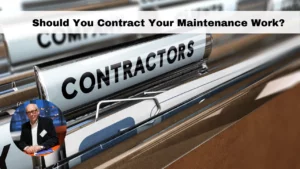Continuous improvement is hard to get to if you don’t know where to start.
Gathering the right data about your maintenance team
Imagine you are walking the floor of your plant, gathering information for a maintenance assessment. You ask the front line, “Hey, are jobs being planned before scheduling?” The answer will most likely be “yes” – but how do you know for sure?
You need to go into more detail. Here are just a few things you need to do to get that detail:
- Look around the plant to see if parts and tools are ready to go and labeled with Work Order numbers, etc. in the staging areas.
- Do a detailed review of daily and weekly schedules to check for compliance.
- Check to see how much of the scheduled jobs were planned.
This is already a lot of work, and it isn’t even 1/10th of what is needed to do a detailed assessment!
Continuous improvement needs consistency
It’s easy to get overwhelmed with all the work that exists. It can be even more difficult with managers just trying new programs instead of keeping what is already in place.
This often leads to new initiatives starting every other year or so, but nothing improves. You can become stagnant this way – and it can be quite a headache.
If you want to improve, start with this:
- Determine the reliability and maintenance best practices for your organization. Doing this helps you develop an assessment process.
- Conduct the assessment yearly of how well these best practices are performed.
For reliability and maintenance management, consistency is the key to improvement. Managers should reinforce what the best practices are, make an agreement with the team about how to achieve the goals, and communicate when goals are met or not. Read Kotter’s 8-step process for leading change as a guide to help you. IDCON finds Kotter’s method is easy to follow and implement.
The problem you may run into is time and resources. Who in the plant possibly has the time to investigate what is going on in the organization and gather the information about current maintenance practices to come up with this detailed process?
At IDCON we are of course biased– but we believe that the best way to do a Maintenance Assessment is by working with a third party. It is very difficult to focus on a detailed assessment when you have so many other responsibilities demanding your attention throughout the day.
Learn about the PROS and CONS of internal assessment teams.
When choosing a third party, it is important to make sure that they can see your organization objectively and not be focused on selling you some engineering service or a fancy new computer system. It must be clear that they won’t be afraid to speak their mind while taking your organization’s specific situation into consideration.
At IDCON, not only do we provide maintenance assessments as described above, but we can also train you to become an IDCON Certified Maintenance Assessor to successfully perform Maintenance Assessments. Contact us to learn how your organization can benefit from becoming certified.
We hope you enjoy this second Maintenance Assessment video – stay tuned!





